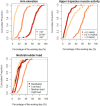Can a metric combining arm elevation and trapezius muscle activity predict neck/shoulder pain? A prospective cohort study in construction and healthcare
- PMID: 33278002
- PMCID: PMC8068682
- DOI: 10.1007/s00420-020-01610-w
Can a metric combining arm elevation and trapezius muscle activity predict neck/shoulder pain? A prospective cohort study in construction and healthcare
Abstract
Objective: To determine whether a composite metric of arm elevation and trapezius activity (i.e. neck/shoulder load) is more strongly associated with the 2-year course of neck and shoulder pain intensity (NSPi) among construction and healthcare workers than each exposure separately.
Methods: Dominant arm elevation and upper trapezius muscle activity were estimated in construction and healthcare employees (n = 118) at baseline, using accelerometry and normalized surface electromyography (%MVE), respectively. At baseline and every 6 months for 2 years, workers reported NSPi (score 0-3). Compositions of working time were determined for arm elevation (< 30°; 30-60°; > 60°), trapezius activity (< 0.5%; 0.5-7.0%; > 7.0%MVE), and a composite metric "neck/shoulder load" (restitution, low, medium, and high load). Associations between each of these three compositions and the 2-year course of NSPi were determined using linear mixed models.
Results: Associations between exposure compositions and the course of NSPi were all weak and in general uncertain. Time spent in 0.5-7.0%MVE showed the largest and most certain association with changes in NSPi during follow-up (β = - 0.13; p = 0.037; corresponding to a -0.01 change in NPSi every 6 months). Among pain-free workers at baseline, medium (β = - 0.23; p = 0.039) and high (β = 0.15; p = 0.031) neck/shoulder load contributed the most to explaining changes in NSPi.
Conclusion: The composite metric of neck/shoulder load did not show a stronger association with the course of NSPi than arm elevation or trapezius activity alone in the entire population, while some indications of a stronger association were found among those who were pain-free at baseline.
Keywords: Actigraphy; Compositional data analysis; Electromyography; Musculoskeletal pain; Neck/shoulder load; Physically demanding work.
Conflict of interest statement
The authors declare that they have no conflict of interest.
Figures
References
MeSH terms
Grants and funding
LinkOut - more resources
Full Text Sources
Medical



